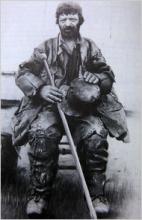The East Coast’s Leather Man seems more like an urban legend than anything else. In the late 19thcentury, a man dressed entirely in a leather suit made from discarded shoe leather walked a circuit of 365 miles every 34 days around New York and Connecticut. He rarely spoke and when he did, it was in broken English. He set up a series of lean-tos as he made his way around the states. He also lived in a series of caves, many of which haven’t yet been rediscovered.
But the Leather Man was no urban legend. Misidentified for many years as Jules Bourglay, a Frenchmen, Connecticut and New York residents seemingly had no end to the tales they would tell about the Leather Man. His nods and grunts allegedly would confirm these tales’ truth. A prominent Leather Man scholar in the 1950’s estimated that the tales of the Leather Man ran into the hundred thousands, even though most of these people had never seen the vagabond.
One explanation to the Leather Man’s habits was that he was bereft by his life’s circumstance. Bourglay had lived in Lyons, France and had fallen in love with Margaret Laron, a leather merchant’s daughter. Margaret’s father did not approve of Bourglay because he was a wood carver, but her father agreed to let Bourglay marry his daughter if he became a leather purchaser. Bourglay was doing well with the firm, but one day the price of leather dropped overnight and Jules had bought too much leather. He had ruined his father-in-law-to-be’s leather company.
After that, Jules started wandering the streets of the city and was put under physician care. Somehow—this is where the Connecticut residents loose the trail—Jules came to Harwinton, Connecticut wearing an outfit of leather patches. He continued on his trail for nearly a third of a century through Westchester County, New York and western Connecticut. His schedule was so exacting that people supposedly set their watches by him—he was only late once during an 1888 blizzard.
Not surprisingly, Connecticut and New York lore turned out to be fabricated. Jules Bourglay was not actually even the Leather Man at all. Turns out that the name Jules Bourglay was printed and later retracted from a newspaper in 1884.
Recently, the Leather Man was in the news again. In March, a team of historians and anthropologists went to the Leather Man’s assumed gravesite in the Sparta Cemetery in Ossining, New York. The grave was next to Route 9 and marked with a small plaque bearing the wrong name.
The team was interested in unearthing the man’s identity and why he did what he did. They wanted to see whether or not the quiet man was autistic. Dissenters said that a man who was so private in life should be able to stay that way in death.
And he could. The Leather Man kept his secrets. When researchers dug up the grave where the Leather Man was buried, all they found were coffin nails. His body had already decomposed.
Even though they couldn’t find much of him, the researchers still reburied the Leather Man’s coffin nails and dirt with a new headstone, coffin and a brass plate to mark the grave. His secrets will probably be safe for eternity.
